GeoJam Helps Edison Eighth Graders Discover That Mathematics Is Fun
December 20, 2018

A team of Edison Middle School Eighth Graders play Tomb Raiders during GeoJam 2018.
On Friday, December 14th, 26 Illinois undergraduate students who intend to teach mathematics one day visited Edison Middle School in Champaign as part of the Curriculum and Instruction (C&I) Department’s annual math outreach, GeoJam. In addition to allowing the school's 220 or so eighth graders to explore a variety of ways that mathematics can be used outside of their math class at school, through the event they discovered that teamwork can be helpful in problem solving. Plus, and probably most importantly, they also learned that math can be fun.
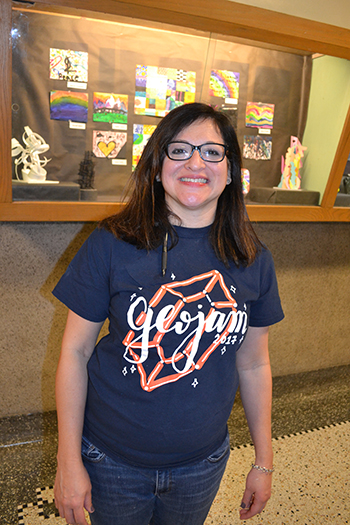
C&I Professor of Math Education, Gloriana Gonzalez.
This year’s GeoJam was organized by Gloriana Gonzalez, a C&I Professor in Math Education who was helping organize the event for the second year in a row, and C&I instructor Adam Poetzel, whose instructional focus is to prepare and train pre-service mathematics teachers to effectively teach diverse K–12 students. Participating Illinois students were in the Secondary Mathematics Education Program (future high school teachers) from Poetzel’s CI 403 course, and Middle Grades majors from Gonzalez’ CI 402 course.
Begun in spring of 2006 by C&I Professor of Mathematics Education Rochelle Gutiérrez, GeoJam is designed to “allow students to experience a creative, collaborative side of mathematics that often is underrepresented in a typical school mathematics class,” explains Poetzel. He says another goal of GeoJam is to foster collaboration and teamwork amongst the younger students. “So we want students to get a taste of mathematical challenges that require reasoning of the team in order to accomplish them.”
So instead of going to their math classes for the day, Edison students were assigned to teams and rotated through three of the eight different GeoJam activities, collaborating to solve the various games and puzzles. Participating Illinois students had come up with the different activities in order to help the younger students have fun while exploring different math concepts they themselves had been learning through their studies.

A team of Edison Middle School eighth graders playing the "Cookie Monster" game debate how many cookies to select during their turn.
For example, during the Cookie Monster game, Edison students were encouraged to use math to beat their opponent. Based off of a game originally called NIM, this game featured cookies in multiples of four, plus a block of “stinky” cheese. Teams were to take either 1, 2, or 3 cookies per turn, and took turns getting to start first. Teams that ended up with the stinky cheese lost all of their cookies. The younger students were to figure out that if the opposing team chose one cookie, they should choose three; if their opponent chose two, then they should choose two, and so on.
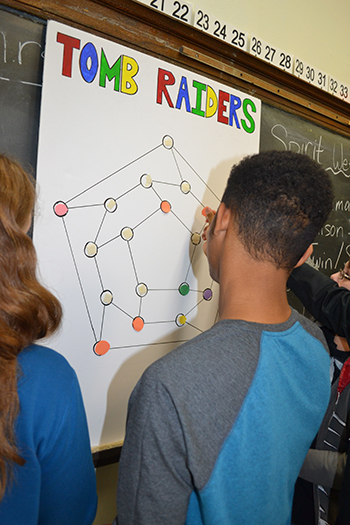
An Edison Middle School eighth grader places one of his pieces down while playing Tomb Raiders
This is the scenario for the GeoJam Escape Room: the players are all trapped inside the escape room, and poison gas is coming through the vents. The antidote is in the big box (actually full of candy!). Players are to work as a team to solve four different puzzles, the answer of which will open the padlocks locking the four locked bags or boxes, allowing them to access the antidote.
In the Spy Training activity, Edison teams attempting to finish their spy training to become official spies used geometric shapes called Pentominoes to unlock doors by filling them in the correct configurations.
In the Tomb Raiders activity, team members sought to unlock hidden treasures by placing different-colored jewels on a special map so that no two connected regions were occupied by the same color. “The lock only ‘opened’ if they figured out how to do it with the least number of colors possible,” Poetzel explains, adding that “This game was based on the ‘Four-Color theorem,’ a famous theorem proved here at UIUC.”
Another popular game was Tangram Avengers. To “Help the Avengers Save the Universe!” players had seven minutes to bring back to life as many Avengers as possible. (If you recall, in the last movie, Avengers: Infinity War, the wicked Thanos fulfilled his dastardly plan to destroy half of all life in the universe, as with a snap of his fingers, people began to disintegrate, including several Marvel characters: SpiderMan, Black Panther, Groot, and Dr. Strange.) To “bring them back to life,” players were to each use the geometric shape they’d been assigned, working with their teammates to make a tangram: a Chinese geometric puzzle consisting of a square cut into seven pieces and arranged to make various shapes.
According to Patrick Pavilonis, a senior in Middle Grades Education who helped with the Avengers activity, “They all seem to like Avengers,” he says, then explains, “and they have to do some sort of action after they complete a puzzle, like shoot spideywebs or something like that. So that's fun.”
Additional games included The Mummy’s Magic Triangle, Bridges to Math-tropolis, and Snowman Shuffle.

Adam Poetzel (second from the left) watches as Edison Middle School students play "The Mummy's Magic Triangle."
According to Poetzel, GeoJam activities are different than regular school math, but still “have a lot of the same logical thinking, spatial reasoning, use of numeric patterns, shapes,” in hopes that the younger students “leave the day with a positive experience with mathematics and hopefully leave with a lasting memory of something they really enjoy having to do with mathematics.” To further ensure that the participants understood how the different activities connected to math, at the end of each game, the college students revealed the hidden mathematics behind it. “So students see how in these fun games they did, there are often mathematical principles or theories at work that they didn't even realize were there,” the secondary and elementary math education instructor explains.
Agreeing that GeoJam helps the students explore mathematics principles far beyond what they get in school, Gonzalez acknowledges:
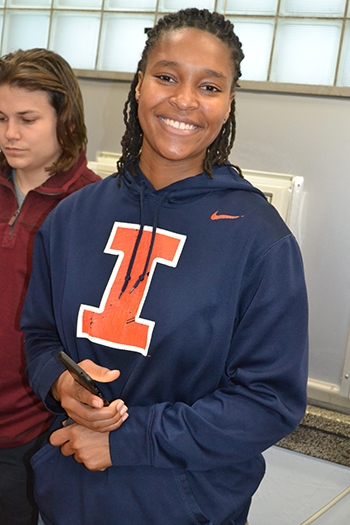
Ciera Nickerson, an Illinois senior in math secondary education
“Sometimes, math in school can be perceived as challenging or boring, or the same. This is a chance for them to see that math is much more than we do in school. That they can work together, be creative, have fun. And it's supposed to be a celebration of math that's beyond testing, exams. It's just about having fun.”
Like Gonzalez, Ciera Nickerson, an Illinois senior in math secondary education, believes that GeoJam gave the Edison middle school kids “the opportunity to see what math is like outside of what they do in the classroom. A lot of the math that we study can be transformed into different games and projects which they probably have not seen before.”
Nickerson says she and her two partners, who created the GeoJam Escape Room "came up with different games that involve patterns, because patterns is a really big thing in math. And a lot of times, when people think about math, they don't think about the patterns we have to create in order to do math. And so we thought it would be fun to be able to play with those patterns through sudoku games, puzzles, and riddles. They all involve some sort of mathematical thinking and skills."

Patrick Pavilonis (second from the right) watches Edison Middle School students play "Tangram Avengers."
Patrick Pavilonis shares that he believes GeoJam was beneficial for middle school students because the problems they designed were “not directly math based. You don't see the math right away. But there is math behind it.” He adds that the younger students also learn a bit about teamwork. “So you work together as a team to solve some sort of scenario-based problem,” he adds. He adds that another goal was to make sure the kids could relate to the activities. “We're supposed to make it relevant to them, so we made it Avengers themed. So we're bringing the Avengers back to life. And it's a fun thing for us to do.”
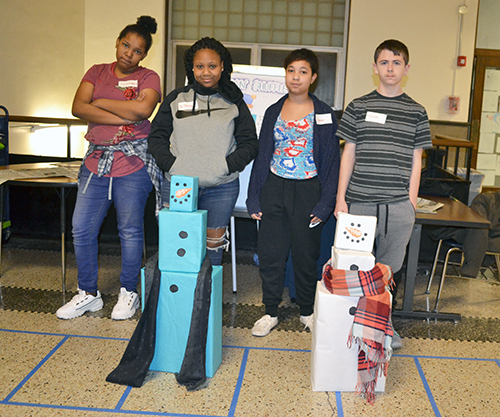
A team of eighth graders with the snowmen the built during the Snowman Shuffle.
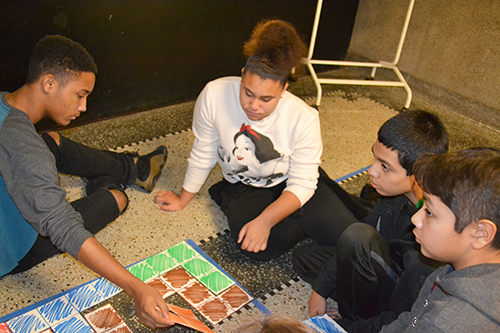
A team of eighth graders doing the Spy Training activity use pentominoes to complete the activity.
And while the Edison students hopefully gained a greater understanding of and increased interest in mathematics, they weren’t the only ones who benefitted. The Illinois students, who are math teachers in training, also benefitted. For instance, Nickerson says participating in GeoJam gave her and her fellow college students the opportunity to show the younger students things they’ve been learning in their college courses.
Gonzalez shares how Geojam benefits the college students. “Our students learn that teaching math goes beyond what you do in the classroom, and it's about engaging kids, making sure that they feel that math is fun, math is something they can enjoy, they can do.” She adds that the event also gives her students a chance to “encourage collaboration, and engage the school community in a celebration of math.”
According to Poetzel, the Illinois students also experienced designing activities outside of the curriculum to engage the students.

Two Illinois students interact with the team of Edison Middle School eighth graders they're playing against as they select their cookies in the "Cookie Monster" game.
“We really want them also to be open to bringing in some different types of learning experiences that engage students in different ways,” Poetzel explains. “We'd like as teachers to think beyond the curriculum, to think about engaging students in meaningful mathematical tasks that encourage collaboration, that leap off the page, that are life-sized tasks.” He adds that the college students not only experienced creating these challenges, but learned planning, thinking about how to encourage teamwork, giving clear directions, and managing a group of students. “So in the end,” adds Poetzel, “they're practicing a lot of skills that a quality teacher needs to possess in creating and managing these games today.”
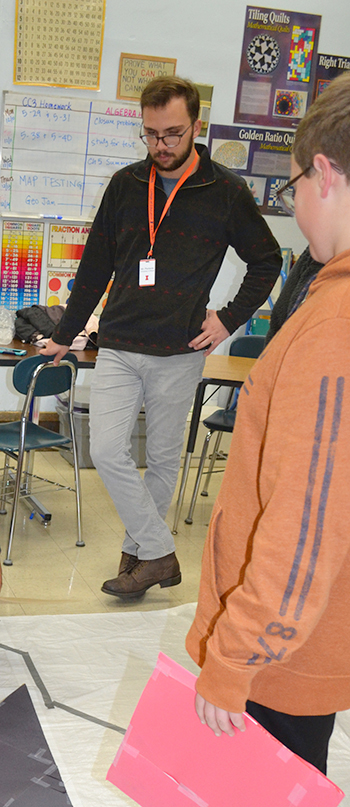
Patrick Pavilonis watches as the eighth graders complete an Avengers Tangram.
GeoJam provides additional ways the college students can interact with the schools and the younger students. For instance, Patrick Pavilonis, a senior in Middle Grades Education who interned at Edison during the Spring 2018 semester, says that most of the students who participated in GeoJam are at middle schools almost every day, because they’re going to be middle school or high school teachers. So Geojam gives them additional experiences interacting with the middle school students. “We're just helping them out and getting them related to the kids on the college campus and getting to know them.”
Poetzel adds that C&I also does GeoJam as a way of saying, “thank you!” to local partners for providing intern opportunities for Illinois students.
“We want to give a gift back to schools,” Poetzel says. “We appreciate the partnership of local schools. At Edison, we send student observers and teachers here, so it's nice to send a gift back to the school for the teachers who work with us to help provide them with...an interesting day that would be hard for them to do on their own at this scale.”
What kind of impact did Geojam seem to have on the kids and did they enjoy it? Pavilonis seemed to think so. Regarding what his activity, “Tangram Avengers,” taught the youngsters about math, he says, “Our activity helps with spatial awareness and geometry and being able to visualize where shapes and stuff go. So I think they're picking up on the math.” Plus, he and his teammates took the kids through a "Did-You-Know" sheet, that gave them the background on tangrams, and other fun facts.
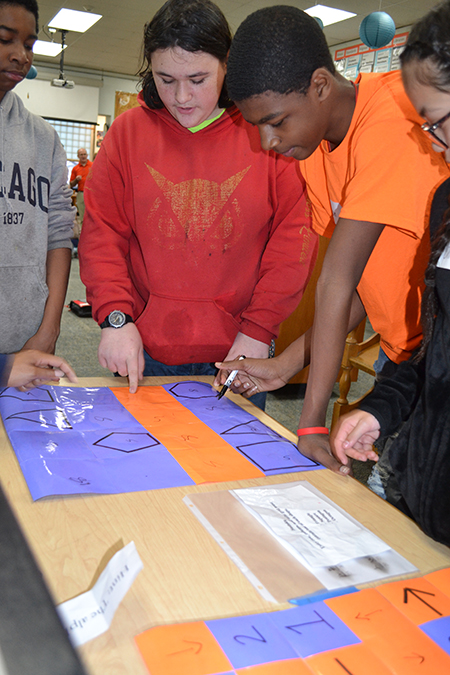
A team of Edison Middle School students make a decision while playing the GeoJam Escape Room.
Below: After winning the GeoJam Escape Room game, the Edison students accessed the antidote to the poison (candy!)
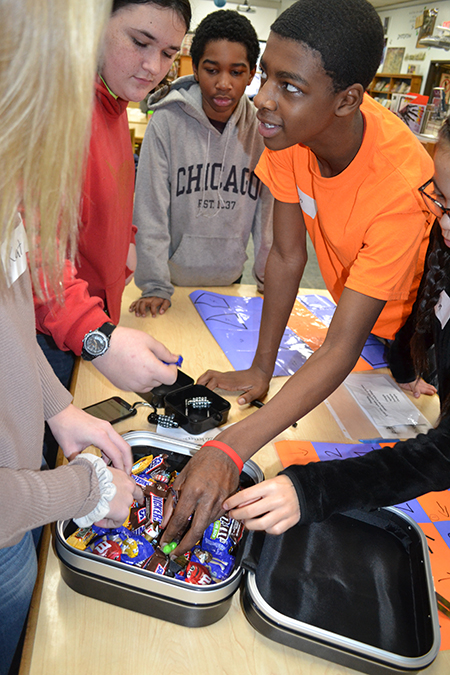
History of GeoJam. Rochelle Gutiérrez, C&I Professor of Mathematics Education, began GeoJam as part of the secondary math education program in spring of 2006. She reports, “I've had the pleasure of helping run and participate in GeoJam 2006-2017,” adding that, "It's been a great tradition, and our students are really making an impact on local schools.” Although in 2018, she had to curtail her involvement, she was able to attend Poetzel’s class in order to “help give a bit of feedback to some of his groups when they were doing mock presentations in preparation for the event,” and also visited this year’s GeoJam “to show support for the students' work.”
From 2006-2016, the event was at local high schools (Central High, 2006–2014 and Urbana High, 2014–2016) during the evening, and was a competition where students could earn prizes from local businesses. In 2009, GeoJam was expanded to include Edison Middle School, with events similar to the 2018 GeoJam, which took place on a school day with students participating in lieu of going to their math classes. However, due to changes in the program, GeoJam currently only partners with Edison Middle School.
Gutiérrez indicates that throughout the history of GeoJam, pre-service teachers developed the math stations to involve the body and not look like school math; did fundraising (going to local businesses to get donations); updated the website; ran publicity for the event (getting math professors and others to consider attending); organized and ran registration, evaluation, and prizes at the event; served as school liaisons with Edison teachers in coordinating how the event would work there; and served as emcees for the evening event where community members and parents were also invited to attend and participate in smaller math challenges to win prizes.
Story and photos by Elizabeth Innes, Communications Specialist, I-STEM Education Initiative
More: Champaign-Urbana Community, Funded, K-12 Outreach, Math, Teacher Professional Development, Underserved Minorities, 2013
For more information about the College of Education Math teacher education programs and outreach, see the following I-STEM webarticles:
- Noyce Scholars: Taking Student-Centered Math to High-Needs Schools
- Noyce: Training Math Teachers Who Foster Equity in the K-12 Classroom
For more information about past GeoJam events from 2009–2017, click below:
2009, 2010, 2011, 2012, 2013, 2014, 2015, 2016, 2017

A team of Edison students by the Avengers Tangram they just solved.













.jpg)
















